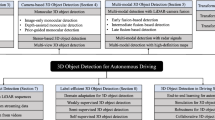Abstract
Intelligent vehicles use surround sensors which perceive their environment and therefore enable automatic vehicle control. As already small errors in sensor data measurement and interpretation could lead to severe accidents, future object detection algorithms must function safely and reliably. However, adverse weather conditions, illustrated here using the example of rain, attenuate the sensor signals and thus limit sensor performance. The indoor rain simulation facility at CARISSMA enables reproducible measurements of predefined scenarios under varying conditions of rain. This simulator is used to systematically investigate the effects of rain on camera, lidar, and radar sensor data. This paper aims at (1) comparing the performance of simple object detection algorithms under clear weather conditions, (2) visualizing/discussing the direct negative effects of the same algorithms under adverse weather conditions, and (3) summarizing the identified challenges and pointing out future work.
Access this chapter
Tax calculation will be finalised at checkout
Purchases are for personal use only
Similar content being viewed by others
References
Dalal, N., Triggs, B.: Histograms of oriented gradients for human detection. In: 2005 IEEE Computer Society Conference on Computer Vision and Pattern Recognition (CVPR 2005), pp. 886–893. IEEE (2005)
Duthon, P., Bernardin, F., Chausse, F., Colomb, M.: Methodology used to evaluate computer vision algorithms in adverse weather conditions. Transp. Res. Procedia 14, 2178–2187 (2016)
Ester, M., Kriegel, H.P., Sander, J., Xu, X.: A density-based algorithm for discovering clusters a density-based algorithm for discovering clusters in large spatial databases with noise. In: Proceedings of the Second International Conference on Knowledge Discovery and Data Mining, KDD 1996, pp. 226–231. AAAI Press (1996)
Fischler, M.A., Bolles, R.C.: Random sample consensus: a paradigm for model fitting with applications to image analysis and automated cartography, vol. 24, pp. 381–395. ACM, New York (1981)
Garg, K., Nayar, S.K.: Photometric model of a rain drop. CMU Technical report (2003)
Garg, K., Nayar, S.K.: Detection and removal of rain from videos. In: Computer Vision and Pattern Recognition (2004)
Garg, K., Nayar, S.K.: Vision and rain. Int. J. Comput. Vis. 75(1), 3–27 (2007)
Gourova, R., Krasnov, O., Yarovoy, A.: Analysis of rain clutter detections in commercial 77 GHz automotive radar. In: 2017 European Radar Conference EURAD, pp. 25–28 (2017)
Rohling, H.: Radar CFAR thresholding in clutter and multiple target situations. IEEE Trans. Aerosp. Electron. Syst. AES–19(4), 608–621 (1983)
Rohling, H.: Ordered statistic CFAR technique - an overview. In: 2011 12th International Radar Symposium (IRS), pp. 631–638 (2011)
Hasirlioglu, S., Doric, I., Kamann, A., Riener, A.: Reproducible fog simulation for testing automotive surround sensors. In: 2017 IEEE 85th Vehicular Technology Conference (VTC Spring), pp. 1–7. IEEE (2017)
Hasirlioglu, S., Kamann, A., Doric, I., Brandmeier, T.: Test methodology for rain influence on automotive surround sensors. In: 2016 IEEE 19th International Conference on Intelligent Transportation Systems (ITSC), pp. 2242–2247. IEEE (2016)
Hassen, A.A.: Indicators for the signal degradation and optimization of automotive radar sensors under adverse weather conditions: Zugl.: Darmstadt, Techn. Univ., Diss., 2006. Berichte aus der Hochfrequenztechnik, Shaker, Aachen (2007)
Krizhevsky, A., Sutskever, I., Hinton, G.E.: ImageNet classification with deep convolutional neural networks. In: Proceedings of the 25th International Conference on Neural Information Processing Systems - Volume 1, NIPS 2012. pp. 1097–1105. Curran Associates Inc., USA (2012)
Rasshofer, R.H., Spies, M., Spies, H.: Influences of weather phenomena on automotive laser radar systems. Adv. Radio Sci. 9, 49–60 (2011)
Sandner, V.: Development of a test target for AEB systems. In: 23rd International Technical Conference on the Enhanced Safety of Vehicles (ESV): Research Collaboration to Benefit Safety of All Road Users (2013)
Torr, P., Zisserman, A.: MLESAC: a new robust estimator with application to estimating image geometry. Comput. Vis. Image Underst. 78(1), 138–156 (2000)
Viola, P., Jones, M.: Rapid object detection using a boosted cascade of simple features. In: Proceedings of the 2001 IEEE Computer Society Conference on Computer Vision and Pattern Recognition, CVPR 2001. pp. I-511–I-518. IEEE (2001)
Wojtanowski, J., Zygmunt, M., Kaszczuk, M., Mierczyk, Z., Muzal, M.: Comparison of 905 nm and 1550 nm semiconductor laser rangefinders’ performance deterioration due to adverse environmental conditions. Opto-Electron. Rev. 22(3), 183–190 (2014)
Acknowledgment
We applied the SDC approach for the sequence of authors. The authors would like to thank the master students Al-Bahr Ayad Ameen Sadeq, Altinbas Selim, Intriz Ercan, Ladva Ronak Madhavji, Malaviya Ujval Jaysukhbhai, and Nguyen Huu Anh Huy for implementing the detection algorithms and analyzing the influences on object-level. This work is supported under the FH-Impuls program of the German Federal Ministry of Education and Research (BMBF) under Grant No. 13FH7I01IA.
Author information
Authors and Affiliations
Corresponding author
Editor information
Editors and Affiliations
Rights and permissions
Copyright information
© 2019 ICST Institute for Computer Sciences, Social Informatics and Telecommunications Engineering
About this paper
Cite this paper
Hasirlioglu, S., Riener, A. (2019). Challenges in Object Detection Under Rainy Weather Conditions. In: Ferreira, J., Martins, A., Monteiro, V. (eds) Intelligent Transport Systems, From Research and Development to the Market Uptake. INTSYS 2018. Lecture Notes of the Institute for Computer Sciences, Social Informatics and Telecommunications Engineering, vol 267. Springer, Cham. https://doi.org/10.1007/978-3-030-14757-0_5
Download citation
DOI: https://doi.org/10.1007/978-3-030-14757-0_5
Published:
Publisher Name: Springer, Cham
Print ISBN: 978-3-030-14756-3
Online ISBN: 978-3-030-14757-0
eBook Packages: Computer ScienceComputer Science (R0)




